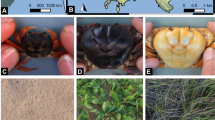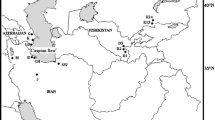Abstract
Pelage color variants have been documented in some small mammals, but there is not any reported about coat color variation in shrews. Here, pelage color variants of the two sibling species (Sorex cylindricauda and Sorex bedfordiae) were uncovered in different sampling sites. Our data may initiate new interest to pelage color variants in small mammals. Furthermore, the classification of two striped shrews has been controversial for several decades. We conducted a detailed examination of the morphometric characters for the two sibling shrews. Significant differences between the two species morphologically confirmed the two-species classification status.




Similar content being viewed by others
References
Allen GM (1923) New Chinese insectivores. Am Mus Novit 100:1–11
Allen GM (1938) The mammals of China and Mongolia. Central Asiatic expeditions of the American Museum of Natural History, New York. 11, Section 1, pp. 620
Belk MC, Smith MH (1996) Pelage coloration in oldfield mice (Peromyscus polionotus): antipredator adaptation? J Mammal 77:882–890
Caro T (2005) The adaptive significance of coloration in mammals. Bioscience 55:125–136
Cloudsley-Thompson JL (1999) Multiple factors in the evolution of animal coloration. Naturwissenschaften 86:123–132
Corbet GB (1978) The mammals of the Palaearctic region: a taxonomic review. British Museum (Natural History), Cornell University Press, London, p 314
D’Elía G, Pardiñas UFJ (2004) Systematics of Argentinean, Paraguayan, and Uruguayan swamp rats of the genus Scapteromys (Rodentia, Cricetidae, Sigmodontinae). J Mammal 85:897–910
Ellerman JR, Morrison-Scott TCS (1966) Checklist of Palaearctic and Indian mammals 1758–1946. British Museum (Natural History), London
Findley JS (1955) Speciation of the wandering shrew. University Kansas Publication, Museum of Natural History, vol. 9, pp 1–68
Ge D, Lissovsky AA, Xia L, Cheng C, Smith AT, Yang Q (2012) Reevaluation of several taxa of Chinese lagomorphs (Mammalia: Lagomorpha) described on the basis of pelage phenotype variation. Mamm Biol 77:113–123
Gloger C (1833) Das abandern der vogel durch einfluss desklimas. A. Schulz, Breslau
He K, Li YJ, Brandley MC, Lin LK, Wang YX, Zhang YP, Jiang XL (2010) A multi-locus phylogeny of Nectogalini shrews and influences of the paleoclimate on speciation and evolution. Mol Phylogenet Evol 56:734–746
Hoekstra HE, Nachman MW (2003) Different genes underlie adaptive melanism in different populations of rock pocket mice. Mol Ecol 2:1185–1194
Hoffmann RS (1987) A review of the systematics and distribution of Chinese red-toothed shrews (Mammalia: Soricinae). Acta Theriol Sin 7:100–139 (In Chinese)
Hutterer R (2005) Order Soricomorpha. In: Wilson DE, Reeder DM (eds) Mammal species of the world, 3rd edn. The Johns Hopkins University Press, Baltimore, pp 220–311
Junge JA, Hoffmann RS (1981) An annotated key to the long-tailed shrews (genus Sorex) of the United States and Canada, with notes on Middle American Sorex. Occasional Papers, Museum of Natural History, University of Kansas, vol. 94, pp 1–48
Lai YC, Shiroishi T, Moriwaki K, Motokawa M, Yu HT (2008) Variation of coat color in house mice throughout Asia. J Zool 274:270–276
Lunde DP, Musser GG, Ziegler T (2004) Description of a new species of Crocidura (Soricomorpha: Soricidae, Crocidurinae) from Ke Go Nature Reserve, Vietnam. Mamm Study 29:27–36
Majerus MEN, Mundy NI (2003) Mammalian melanism: natural selection in black and white. Trends Genet 19:585–588
McGraw KJ (2007) Dietary mineral content influences the expression of melanin-based ornamental coloration. Behav Ecol 18:137–142
Milne-Edwards A (1871) Descriptions of new species, in footnotes, pp 91–93. In: David A (ed) Journal d’un voyage en Mongolia et en Chine fait en 1866–68. Nouvelles Archives Museum d’History Nature Paris 7:75–100
Motokawa M, Wu Y, Harada M (2009) Karyotypes of six soricomorph species from Emei Shan, Sichuan Province, China. Zool Sci 26:791–797
Nachman MW, Hoekstra HE, D’Agostino SL (2003) The genetic basis of adaptive melanism in pocket mice. Proc Natl Acad Sci U S A 100:5268–5273
Ohdachi SD, Hasegawa M, Iwasa MA, Vogel P, Oshida T, Lin LK, Abe H (2006) Molecular phylogenetics of Soricid shrews (Mammalia) based on mitochondrial cytochrome b gene sequences: with special reference to the Soricinae. J Zool 270:177–191
Parker TH, Stansberry BM, Becker CD, Gipson PS (2003) Do melanin- or carotenoid-pigmented plumage ornaments signal condition and predict pairing success in the Kentucky Warbler? Condor 105:663–671
Rudd RL (1955) Age, sex and weight comparisons in three species of shrews. J Mammal 36:323–339
Silvers WK (1979) The coat colors of mice. Springer, New York
Smith AT, Johnston CH (2011a) Sorex cylindricauda. In: IUCN 2011. IUCN red list of threatened species. Version 2011.1. Available from: http://www.iucnredlist.org. Accessed 05 October 2013
Smith AT, Johnston CH (2011b) Sorex bedfordiae. In: IUCN 2011. IUCN red list of threatened species. Version 2011.1. Available from: http://www.iucnredlist.org. Accessed 05 October 2013
Smith AT, Xie Y (2009) A guide to the mammals of China. Princeton University Press, Princeton
Smith MH, Carmon JL, Gentry JB (1972) Pelage color polymorphism in Peromyscus polionotus. J Mammal 53:824–833
Steiner CC, Rompler H, Boettger LM, Schoneberg T, Hoekstra HE (2009) The genetic basis of phenotypic convergence in beach mice: similar pigment patterns but different genes. Mol Biol Evol 26:35–45
Stoner CJ, Bininda-Emonds ORP, Caro T (2003) The adaptive significance of coloration in lagomorphs. Biol J Linn Soc 79:309–328
Thomas O (1911) The Duke of Bedford’s zoological exploration of eastern Asia. XIII. On mammals from the provinces of Kan-su and Sze-chwan, western China. Proc Zool Soc London 1911:158–180
Tu FY, Liu SY, Liu Y, Sun ZY, Zhu TH (2010) Phallic morphology of six species of Soricid shrew. Acta Theriol Sin 30:278–282 (In Chinese)
Wang YX (2003) A complete checklist of mammal species and subspecies in China: a taxonomic and geographic reference. China Forestry Publishing House, Beijing, p 394
Wu Y, Wei FW, Yuan CG, Hu JQ (1991) Discussion on identification features of two striped shrews. Sichuan J Zool 9:39–40 (In Chinese)
Yang QS, Xia L, Feng ZJ, Ma Y, Quan GQ, Wu Y (2007) A guide to the measurement of mammal skull V: Insectivora and Chiroptera. Chin J Zool 42:56–62 (In Chinese)
Acknowledgments
We appreciate the constructive comments and suggestions from the two anonymous reviewers. We would like to acknowledge Mr. Rui Liao, Dr. Bo Li, and Dr. Zhixin Wen for collecting the samples in the field. We also thank Prof. Xuelong Jiang and Prof. Jianghong Ran for providing samples for this study. This research was funded by the National Natural Science Foundation of China (no. 30970330; no. 31272274), Applied Basic Research Program of Sichuan Science and Technology Department (no. 2013JY0170), and Experimental Technology and Management of Sichuan Normal University (no. SYJS2013-12).
Author information
Authors and Affiliations
Corresponding author
Additional information
Communicated by: Jan M. Wójcik
Electronic supplementary material
Below is the link to the electronic supplementary material.
Fig. S1
Distribution map and sampling sites of the two species examined in this study (JPEG 422 kb)
Fig. S2
Representative pelage color variation in museum collections in S. bedfordiae from Erlang Mountains in Tianquan County (JPEG 689 kb)
Table S1
(DOC 113 kb)
Table S2
(XLS 30 kb)
Rights and permissions
About this article
Cite this article
Chen, S., Liu, Y., Sun, Z. et al. Morphometric and pelage color variation of two sibling species of shrew (Mammalia: Soricomorpha). Acta Theriol 59, 407–413 (2014). https://doi.org/10.1007/s13364-014-0176-y
Received:
Accepted:
Published:
Issue Date:
DOI: https://doi.org/10.1007/s13364-014-0176-y




